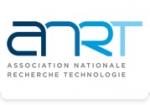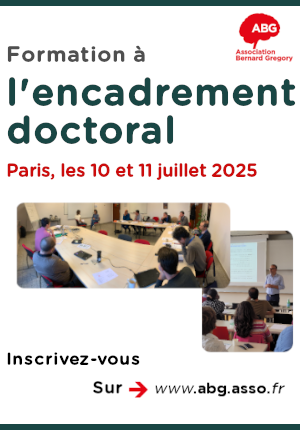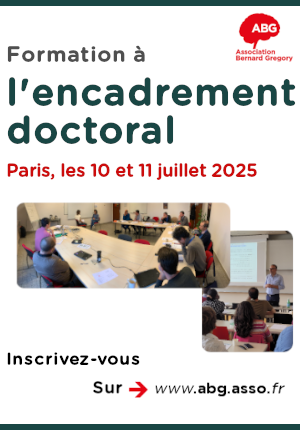Etude d'un facteur d'assemblage de l'ATP synthase impliqué dans une maladie mitochondriale et test de candidats médicaments dans des modèles cellulaire et murin. // Study of an ATP synthase assembly factor involved in mitochondrial disease and testing of
|
ABG-131249
ADUM-60452 |
Sujet de Thèse | |
| 18/04/2025 |
Université de Bordeaux
Bordeaux cedex - France
Etude d'un facteur d'assemblage de l'ATP synthase impliqué dans une maladie mitochondriale et test de candidats médicaments dans des modèles cellulaire et murin. // Study of an ATP synthase assembly factor involved in mitochondrial disease and testing of
- Biologie
maladies mitochondriales , ATP synthase , repositionnement thérapeutique , levure , cellules humaines , souris
mitochondrial diseases , ATP synthase , therapeutic repositioning , yeast , human cells , mouse model
mitochondrial diseases , ATP synthase , therapeutic repositioning , yeast , human cells , mouse model
Description du sujet
L'essentiel de nos besoins en ATP est produit dans la mitochondrie par l'ATP synthase. Il s'agit d'un complexe de 17 sous-unités différentes présentes en une ou plusieurs copies. Les gènes de ces protéines sont localisés dans les génomes nucléaire et mitochondrial. Du fait de cette compartimentation génétique, deux machineries de synthèse protéique, l'une dans le cytosol et l'autre à l'intérieur de la mitochondrie, sont nécessaires à la formation de l'ATP synthase. Après synthèse, les sous-unités d'origine nucléaire sont importées dans l'organelle et s'assemblent avec celles encodées par le génome mitochondrial. Il s'agit d'un processus particulièrement complexe impliquant des protéines qui ne font pas partie du complexe final mais qui sont nécessaires à son assemblage. Nous avons au laboratoire identifié l'une de ces protéines d'assemblage chez la levure Saccharomyces cerevisiae, que nous avons appelée Fmc1 (pour Formation of Mitochondrial Complexes 1). Nous avons trouvé qu'elle intervient spécifiquement dans la formation du sous-domaine catalytique (alpha3beta3) de l'ATP synthase où l'ATP est synthétisé. Récemment, un équivalent de cette protéine a été trouvé chez l'homme, indiquant que le mécanisme de formation de cette enzyme est, à tout le moins en partie, conservé de la levure à l'homme. Des déficiences spécifiques dans l'hexamérisation des sous-unités alpha et beta ont été décrites chez certains patients souffrant d'atteintes neuromusculaires. Il n'existe pas pour l'heure de thérapies réellement curatives contre ces maladies. Les objectifs du projet seront d'identifier des candidats médicaments par des criblages sur le modèle levure déficient du gène FMC1, créé et caractérisé au laboratoire, de tester ces candidats sur des modèle eucaryotes supérieurs (cellules humaines et souris) et d'identifier les mécanismes d'action de ces composés. En plus de proposer des candidats médicaments potentiels pour le traitement des maladies mitochondriales liées à une déficience en ATP synthase, ce projet apportera des informations complémentaires sur le rôle de la protéine Fmc1 chez l'homme.
------------------------------------------------------------------------------------------------------------------------------------------------------------------------
------------------------------------------------------------------------------------------------------------------------------------------------------------------------
Most of our ATP requirements are produced in the mitochondria by ATP synthase. This is a complex of 17 different subunits present in one or more copies. The genes for these proteins are located in the nuclear and mitochondrial genomes. As a result of this genetic compartmentalization, two protein synthesis machineries, one in the cytosol and the other within the mitochondria, are required to form ATP synthase. After synthesis, the subunits of nuclear origin are imported into the organelle and assemble with those encoded by the mitochondrial genome. This is a particularly complex process involving proteins that are not part of the final complex, but are necessary for its assembly. In the laboratory, we have identified one of these assembly proteins in the yeast Saccharomyces cerevisiae, which we have named Fmc1 (for Formation of Mitochondrial Complexes 1). We found that it is specifically involved in the formation of the catalytic subdomain (alpha3beta3) of ATP synthase, where ATP is synthesized. Recently, an equivalent of this protein was found in humans, indicating that the mechanism of formation of this enzyme is, at least in part, conserved from yeast to man. Specific deficiencies in the hexamerization of the alpha and beta subunits have been described in certain patients suffering from neuromuscular disorders. At present, there are no truly curative therapies for these diseases. The aims of the project will be to identify drug candidates by screening on the FMC1-deficient yeast model created and characterized in the laboratory, to test these candidates on higher eukaryotic models (human cells and mice) and to identify the mechanisms of action of these compounds. In addition to proposing potential drug candidates for the treatment of mitochondrial diseases linked to ATP synthase deficiency, this project will provide additional information on the role of the Fmc1 protein in humans.
------------------------------------------------------------------------------------------------------------------------------------------------------------------------
------------------------------------------------------------------------------------------------------------------------------------------------------------------------
Début de la thèse : 01/10/2025
------------------------------------------------------------------------------------------------------------------------------------------------------------------------
------------------------------------------------------------------------------------------------------------------------------------------------------------------------
Most of our ATP requirements are produced in the mitochondria by ATP synthase. This is a complex of 17 different subunits present in one or more copies. The genes for these proteins are located in the nuclear and mitochondrial genomes. As a result of this genetic compartmentalization, two protein synthesis machineries, one in the cytosol and the other within the mitochondria, are required to form ATP synthase. After synthesis, the subunits of nuclear origin are imported into the organelle and assemble with those encoded by the mitochondrial genome. This is a particularly complex process involving proteins that are not part of the final complex, but are necessary for its assembly. In the laboratory, we have identified one of these assembly proteins in the yeast Saccharomyces cerevisiae, which we have named Fmc1 (for Formation of Mitochondrial Complexes 1). We found that it is specifically involved in the formation of the catalytic subdomain (alpha3beta3) of ATP synthase, where ATP is synthesized. Recently, an equivalent of this protein was found in humans, indicating that the mechanism of formation of this enzyme is, at least in part, conserved from yeast to man. Specific deficiencies in the hexamerization of the alpha and beta subunits have been described in certain patients suffering from neuromuscular disorders. At present, there are no truly curative therapies for these diseases. The aims of the project will be to identify drug candidates by screening on the FMC1-deficient yeast model created and characterized in the laboratory, to test these candidates on higher eukaryotic models (human cells and mice) and to identify the mechanisms of action of these compounds. In addition to proposing potential drug candidates for the treatment of mitochondrial diseases linked to ATP synthase deficiency, this project will provide additional information on the role of the Fmc1 protein in humans.
------------------------------------------------------------------------------------------------------------------------------------------------------------------------
------------------------------------------------------------------------------------------------------------------------------------------------------------------------
Début de la thèse : 01/10/2025
Nature du financement
Précisions sur le financement
Financement d'une association ou fondation
Présentation établissement et labo d'accueil
Université de Bordeaux
Etablissement délivrant le doctorat
Université de Bordeaux
Ecole doctorale
154 Sciences de la Vie et de la Santé
Profil du candidat
Compétences principales :
• Solide formation en génétique, biologie cellulaire/moléculaire et biochimie. Des connaissances concernant le fonctionnement des systèmes mitochondriaux seront appréciées.
• Compétences linguistiques : anglais technique appréciée
Savoir-faire :
• Bonne maîtrise des techniques de culture de levure et de cellules mammifères, de microscopie, PCR et RT-q-PCR, western blots, analyses transcriptomiques et expérimentation animale.
• S'adapter rapidement aux nouvelles méthodologies.
• Savoir utiliser les outils informatiques et les logiciels dédiés au traitement des données
Savoir-être :
• Le(a) candidat(e) sera motivé-e, rigoureux-se, doté-e d'un bon sens de l'organisation et capable d'autonomie.
Main skills: • Strong training in genetic, cellular / molecular biology and biochemistry. Knowledge of the functioning of mitochondrial systems will be appreciated • Language skills: technical English appreciated. Know how : • Good knowledge of yeast and mammalian cell culture techniques, microscopy, PCR and RT-q-PCR, western blots, transcriptomic analyzes and animal experimentation. • Adapt quickly to new methodologies • Use IT tools and software dedicated to data processing. Life skills: • The candidate will be motivated, rigorous, good sense of organization and capable of autonomy.
Main skills: • Strong training in genetic, cellular / molecular biology and biochemistry. Knowledge of the functioning of mitochondrial systems will be appreciated • Language skills: technical English appreciated. Know how : • Good knowledge of yeast and mammalian cell culture techniques, microscopy, PCR and RT-q-PCR, western blots, transcriptomic analyzes and animal experimentation. • Adapt quickly to new methodologies • Use IT tools and software dedicated to data processing. Life skills: • The candidate will be motivated, rigorous, good sense of organization and capable of autonomy.
17/05/2025
Postuler
Fermer
Vous avez déjà un compte ?
Nouvel utilisateur ?
Besoin d'informations sur l'ABG ?
Vous souhaitez recevoir nos infolettres ?
Découvrez nos adhérents
 ANRT
ANRT  ASNR - Autorité de sûreté nucléaire et de radioprotection - Siège
ASNR - Autorité de sûreté nucléaire et de radioprotection - Siège  Aérocentre, Pôle d'excellence régional
Aérocentre, Pôle d'excellence régional  Tecknowmetrix
Tecknowmetrix  ADEME
ADEME  CASDEN
CASDEN  Institut Sup'biotech de Paris
Institut Sup'biotech de Paris  PhDOOC
PhDOOC  Généthon
Généthon  ONERA - The French Aerospace Lab
ONERA - The French Aerospace Lab  SUEZ
SUEZ  CESI
CESI  Laboratoire National de Métrologie et d'Essais - LNE
Laboratoire National de Métrologie et d'Essais - LNE  Nokia Bell Labs France
Nokia Bell Labs France  MabDesign
MabDesign  MabDesign
MabDesign  Groupe AFNOR - Association française de normalisation
Groupe AFNOR - Association française de normalisation  TotalEnergies
TotalEnergies  Ifremer
Ifremer





